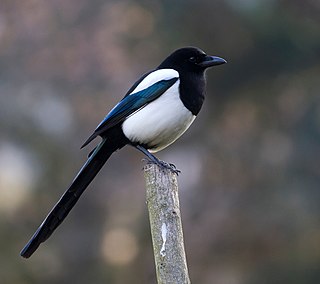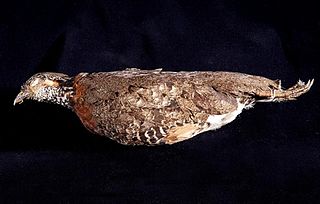
Magpies are birds of the family Corvidae. Like other members of their family, they are widely considered to be intelligent creatures. The Eurasian magpie, for instance, is thought to rank among the world's most intelligent creatures, and is one of the few nonmammalian species able to recognize itself in a mirror test. Magpies have shown the ability to make and use tools, imitate human speech, grieve, play games, and work in teams. They are particularly well known for their songs and were once popular as cagebirds. In addition to other members of the genus Pica, corvids considered magpies are in the genera Cissa, Urocissa, and Cyanopica.

The Taiwan blue magpie, also called the Taiwan magpie, Formosan blue magpie, or the "long-tailed mountain lady", is a bird species in the crow family. It is endemic to Taiwan.

The common green magpie is a member of the crow family, roughly about the size of the Eurasian jay or slightly smaller. In the wild specimens are usually a bright and lush green in colour, slightly lighter on the underside and has a thick black stripe from the bill to the nape. Compared to the other members of its genus, the white-tipped tail is quite long. This all contrasts vividly with the red fleshy eye rims, bill and legs. The wings are reddish maroon.

Cissa is a genus of relatively short-tailed magpies, sometimes known as hunting cissas, that reside in the forests of tropical and subtropical southeast Asia and adjacent regions. The four species are quite similar with bright red bills, primarily green plumage, black mask, and rufous wings.

The Sri Lanka blue magpie or Ceylon magpie is a brightly coloured member of the family Corvidae, found exclusively in Sri Lanka. This species is adapted to hunting in the dense canopy, where it is highly active and nimble. Its flight is rather weak, though, and is rarely used to cover great distances. In spite of the Sri Lanka blue magpie's ability to adapt to the presence of humans, it is classified as vulnerable to extinction due to the fragmentation and destruction of its habitat of dense primary forest in the wet zone of southern Sri Lanka.

The Javan green magpie is a passerine bird in the crow family, Corvidae. This critically endangered species is endemic to montane forests on the Indonesian island of Java. It formerly included the Bornean green magpie as a subspecies, in which case the "combined" species was known as the short-tailed magpie.

The white-winged magpie or Hainan magpie is a passerine bird of the crow family, Corvidae. It is unusual among the members of its genus in that it is black and white, lacking the blue plumage other Urocissa magpies have. Thus, it is sometimes placed in its own monotypic genus, Cissopica, though it appears to have sufficient features to remain in the genus Urocissa. There are two subspecies, the nominate whiteheadi being found in Hainan and xanthomelana found in southern China, northern Vietnam, and north and central Laos. The two subspecies are distinctive and may merit specific status; further research is needed.

The Javan hawk-eagle is a medium-sized, dark brown raptor in the family Accipitridae. It is the national bird of Indonesia, where it is commonly referred to as Garuda, from the bird-like creatures in Hindu and Buddhist mythology. The scientific name commemorates the Bartels family, who discovered it.

The chestnut-necklaced partridge is a species of bird in the family Phasianidae. It is found in forests in the Malay Peninsula and Sumatra. It is threatened by habitat loss and trapping. The International Union for Conservation of Nature (IUCN) has assessed it as vulnerable.

The banded broadbill is a species of bird in the Eurylaimidae typical broadbill family found in Mainland Southeast Asia and the Greater Sunda Islands. It is sometimes split into two species, one including only the nominate subspecies, E. j. javanicus, and one including all the remaining subspecies. It inhabits a variety of forests, along with forest edge, rubber plantations and Falcataria falcata groves, mainly in lowland areas. A striking, large-bodied bird with a length of 21.5–23.0 cm (8.5–9.1 in), it is unlikely to be mistaken for another species. The broadbill is mostly purplish-red, with yellow-streaked black wings, a bright blue beak, a blackish face and greyish chin and upper breast. Females can be told apart from males by their lack of a black neckband, although these are indistinct in Bornean and Javan males. Despite its conspicuous appearance, the bird is usually hard to see due to its sluggishness and is usually only noticed when it vocalises.

The Japanese thrush is a species of bird in the thrush family Turdidae. The species is also known as the grey thrush or the Japanese grey thrush. The species was once split into two subspecies, with birds breeding in China being treated as the subspecies T. c. lateus,, but today differences are attributed to natural variation and the species is treated as being monotypic.

The grey-breasted mountain toucan is a Near Threatened species of bird in the toucan family Ramphastidae. It is found in Colombia, Ecuador and Peru.

The Bornean green magpie is a passerine bird in the crow family, Corvidae. It is endemic to montane forests on the southeast Asian island of Borneo. It was formerly included as a subspecies of the Javan green magpie, but under the common name Short-tailed Green Magpie. Uniquely among the green magpies, the Bornean green magpie has whitish eyes.

The Vietnamese Javan rhinoceros, also known as the Indo-Chinese Javan rhinoceros, is an extinct subspecies of the Javan rhinoceros that formerly lived in Laos, Cambodia, Thailand, Malaysia, and Vietnam. The subspecific term annamiticus derives from the Annamite name of the Indochinese Mountains in Indochina, part of the historical distribution of the subspecies.















